Visit Strasbourg in 2 days
20 must-see POIs, optimized routes and anecdotes.
Loading map...
You will visit the most beautiful points of interest in Strasbourg
















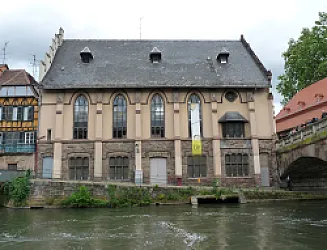
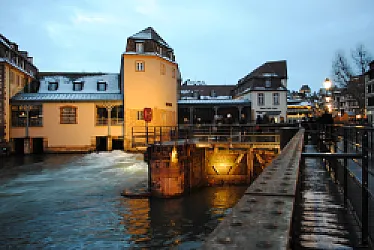
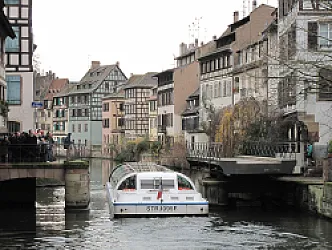

2 Days in Strasbourg — A Love Letter to the Island City
Strasbourg stole my heart the moment I stepped onto its cobbled streets. The city feels like a storybook and a living, breathing capital at once. Locals call it the "Capital of Europe" and the "Capital of Christmas," and yes, the charm is real. Some say it's overrated, but I disagree — its light, history, and warmth are unmistakable. I visited in spring and still dream about the bell chimes and river reflections.
Why visit Strasbourg beyond the famous sights? The city combines grand Gothic spires with cozy timbered alleys. You smell fresh pastries, hear church bells and chatter, and taste tarte flambée in tiny bistros. Iconic places like the Cathedral of Our Lady, the Statue of Gutenberg and Place Saint-Étienne are only the beginning. Walking here feels cinematic: sunlight on canals, ornate facades, and unexpected courtyards. You leave feeling both wonder and a soft, domestic comfort that makes you want to linger.
Planning a trip can feel overwhelming. There is so much to see in Strasbourg that you could stay for weeks. If this is your first visit, you might worry about fitting everything in. That’s exactly why I created this compact and joyful Strasbourg itinerary. Below, I’ll show you how to spend two full days and still breathe. Expect 16 highlights across religion, historic architecture, sculptures, manor houses, and urban charm — including the Seminary of St. Mary Major and Rue de la Division Leclerc.
Key tip: Go early and walk slowly. The Cathedral of Our Lady is best at dawn for light and quiet. Early starts mean fewer crowds and better photos. Walking unlocks hidden alleys and cozy cafés you’ll miss from buses. Wear comfortable shoes and pause for a pastry or coffee in Place Saint-Étienne. This makes your two days feel unhurried and full.
Now let’s dive into the itinerary and discover exactly what to see in Strasbourg, how to savor it, and how to fall in love with the city on your first time in Strasbourg.

Quick Mini Guide to Strasbourg
Where to stay:
- Centre-ville / Grande Île — walkable to Cathedral, Gutenberg statue and Rue de la Division Leclerc; ideal for evening photos of the illuminated façade.
- La Petite France — picturesque timbered houses and canals; quieter for early morning walks.
- Near Place Saint-Étienne — good for cafés, student vibe and quick access to the Seminary of St. Mary Major.
When to visit:
- Spring and early autumn — mild weather, fewer coach-tour crowds at the Cathedral of Our Lady.
- Weekdays morning — climb the cathedral platform before guided tours fill the site.
Things to do:
- Cathedral of Our Lady — buy a slot to climb the tower for panoramic views; don’t miss the Astronomical Clock inside.
- Statue of Gutenberg — quick photo stop and short walk to Rue de la Division Leclerc for local shopping and views toward the cathedral.
- Seminary of St. Mary Major & Place Saint-Étienne — enjoy café culture and occasional concerts; use this area as a slower cultural detour.
- Book an interactive tour: "Secrets of Strasbourg" for hidden history or "The Alchemist STRASBOURG" for an immersive puzzle walk.
Don't forget:
- Validate tram tickets (or use contactless) — trams are fastest between sites.
- Try tarte flambée and local Riesling; small winstubs fill up, reserve for dinner.
- Wear comfortable shoes — cobbles and canal paths reward walking between landmarks.
Day 1 - Strasbourg
10 POIs to discoverDay 1 - Morning à Strasbourg
5 Points of interest - Duration : 3h15 - Distance : 1.2 km - Walking : 0h16
Iron Man Square
- Place de l'Homme-de-Fer takes its name from a statue of a soldier in armor attached in the 18th century to a mansion, now No. 2 on the square.
- During the Second World War, an island of buildings was destroyed to create the current square.

General Kléber Monument
- The General Kléber monument is dedicated to the hero of the Revolutionary Wars, assassinated in Cairo in 1800.
- His remains were embalmed and transported to various locations, including Marseille and Strasbourg.
- In 1838, his ashes were transferred to a vault in Strasbourg's Place Kléber, with a bronze statue representing him.
- General Kléber's bronze statue surmounts his vault, holding the British admiral's letter requesting his departure from Egypt, with a sphinx representing Egypt at his feet.

Aubette
- Built between 1765 and 1778, originally intended for military purposes, the building was used for housing and a guardhouse.
- In 1928, the building was transformed into a leisure complex with rooms such as a cine-dancing and foyer-bar.
- The leisure complex featured various rooms with geometric decorations and biomorphic forms, reflecting the artistic avant-garde of the time.

Rohan Palace
- The palace was built in 1732-1742 for prince-bishop Armand-Gaston-Maximilien de Rohan, replacing the previous episcopal palace.
- The palace thus takes its name from the de Rohan family, with four prince-bishops bearing this name having occupied the diocese of Strasbourg in the 18th century.
- During the French Revolution, the building was used as a place of detention, and after the German annexation of Strasbourg, it housed classes for the Kaiser-Wilhelms-Universität.
- Today, the palace houses three museums: the Museum of Decorative Arts, the Museum of Fine Arts and the Archaeological Museum.
- The palace's interiors include large apartments, such as the synod hall, the bishops' salon, the king's chamber, and the assembly salon, as well as smaller apartments of the prince-bishop, such as Napoleon I's antechamber and bedroom.

Place Kléber
- The square honors Jean-Baptiste Kléber, a French general famous for his participation in the wars of the Revolution and the Egyptian campaign.
- The square is bordered by the Aubette, a neo-classical building constructed in the 18th century.
- A statue of Kléber stands in the center of the square, depicting the general in his feet holding the letter from Admiral Keith.
Day 1 - Afternoon à Strasbourg
5 Points of interest - Duration : 3h45 - Distance : 1 km - Walking : 0h13
Hôtel Cour du Corbeau
- Built in the 15th century, it housed a hostellerie, frequented by such luminaries as the Duke of Bavaria and the Emperor of Austria.
- In 1668, a fire affected the hotel, but it survived and operated as an inn until 1854.
- The Cour du Corbeau, made up of heterogeneous buildings, was restored in the 20th century while preserving its historic character.
- In 1999, archaeological surveys revealed remains from the 15th and 16th centuries.
- The Cour du Corbeau, with its facades and roofs, has been listed as a historic monument since 1930.
- The well in the courtyard has also been a listed monument since 1933.

Place du Château
- This square has had several names over time: Cour de l'évêque, place de l'Evêché, place de la Responsabilité, place du Château du Palais, place du Château Royal, place du Château, Schlossplatz, and again place du Château.
- It has also undergone name changes linked to the region's history: French and then German names during certain periods.
- Built in 1215, it has retained its current name since the end of the Second World War.

Place du Marché Gayot
- Established in 1769 on the site of the Hôtel Canonial de Brunswick, Place du Marché Gayot was originally intended as a herbal and poultry market.
- Houses were soon built around the square, including a salt granary and an inn, as well as half-timbered houses, some of which had low doors to house employees of the episcopal court.
- The square was used as a butcher's meat market and housed a covered market before becoming a parking lot, then restored to accommodate café terraces, restaurants and pedestrians.
- Since 2003, the square has been adorned by Daniel Pontoreau's cast-iron sculpture "Pierre trouée", resembling an enigmatic meteorite that has fallen from the sky.

Neue Bau
- The Neue Bau is a 16th-century historic monument, originally an extension of Strasbourg's Hôtel de Ville.
- It is now the headquarters of the Strasbourg and Alsace Chamber of Commerce and Industry.
- After the destruction of the Pfalz in 1781, the Neue Bau became the new Hôtel de Ville.

Kammerzell House
- Built in 1427, the Maison Kammerzell features richly decorated half-timbering and stands opposite Notre-Dame Cathedral.
- Purchased in 1571 by merchant Martin Braun, carved wooden storeys were added in 1589 in a unique Renaissance style.
- Carved wooden decorations on the facade depict sacred scenes, medieval legends, the five senses, the four ages of life, and other symbols.
- The interior houses a restaurant and a 1910 painting by Léo Schnugg illustrating a Strasbourg culinary anecdote.
Day 2 - Strasbourg
10 POIs to discoverDay 2 - Morning à Strasbourg
5 Points of interest - Duration : 3h45 - Distance : 1.2 km - Walking : 0h15
Pont de la Poste
- Pont de La Poste is a segmental (segmental) arch bridge and road bridge whose construction began in 1904.

Passerelle des Juifs
- Strasbourg's Jewish Footbridge spans the Ill River from Lezay-Marnésia Quay to Republic Square.
- In medieval times, it was the location of the Jewish Gate in the city's old fortifications, leading to the Jewish cemetery.
- Tragically, during the Black Plague outbreak on Valentine's Day in 1349, Jews were burned at this site.

Courthouse
- The courthouse, built in the 1890s, boasts a Greek Revival facade adorned with Ionic columns, allegorical sculptures and sphinxes.
- Allegorical decorative elements and sphinxes are also found inside the building, particularly near the staircases leading to the courtrooms.

Rhine Palace
- Also known as the Kaiserpalast, the Rhina Palace was built in 1883-1888 in a Germanic neo-renaissance style.
- Originally an imperial palace, the building is now used as an official building.
- The palace garden houses an archaeological collection and sculptures.
- The building itself has undergone transformations over the years, including use as a military hospital during the First World War.

Opéra national du Rhin
- The National Rhine Opera is managed by the cities of Strasbourg, Mulhouse and Colmar, each with its own creative activity: opera in Strasbourg, Ballet de l'Opéra national du Rhin in Mulhouse and Opéra Studio in Colmar.
- The institution has been in existence for over 50 years and collaborates with the Orchestre philharmonique de Strasbourg and the Orchestre symphonique de Mulhouse for musical and choreographic productions.
Day 2 - Afternoon à Strasbourg
5 Points of interest - Duration : 3h30 - Distance : 0.6 km - Walking : 0h07
Petite France
- La Petite France, a picturesque district listed as a UNESCO World Heritage Site since 1988. The district is bordered by various waterways: Ill, canal de navigation, Spitz mill canals, Düntz and Zorn.
- The district is bounded by quays and streets, such as Quai de la Bruche, Rue du Bain-aux-Plantes, Place Benjamin-Zix, etc.
- Petite France was historically made up of several distinct entities: the Ponts couverts, the Moulins district, the area around rue du Bain-aux-Plantes.
- An establishment for syphilis patients was transferred to Petite France in 1687, giving the district its name.
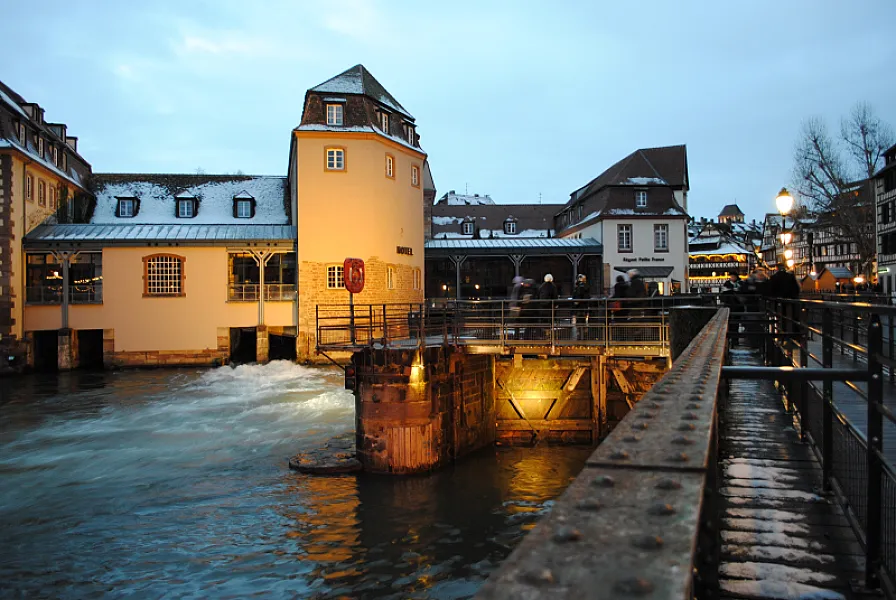
Ancient Coolers
- Strasbourg's former glaciers were once an artificial cold factory with machines from the Quiri company, from 1897 to 1990.
- The buildings have been transformed into a five-star hotel called Le Régent Petite France.
- The factory used liquid gas vaporization to produce cold, similar to the way domestic refrigerators work.
- The factory ceased production on May 31, 1990.
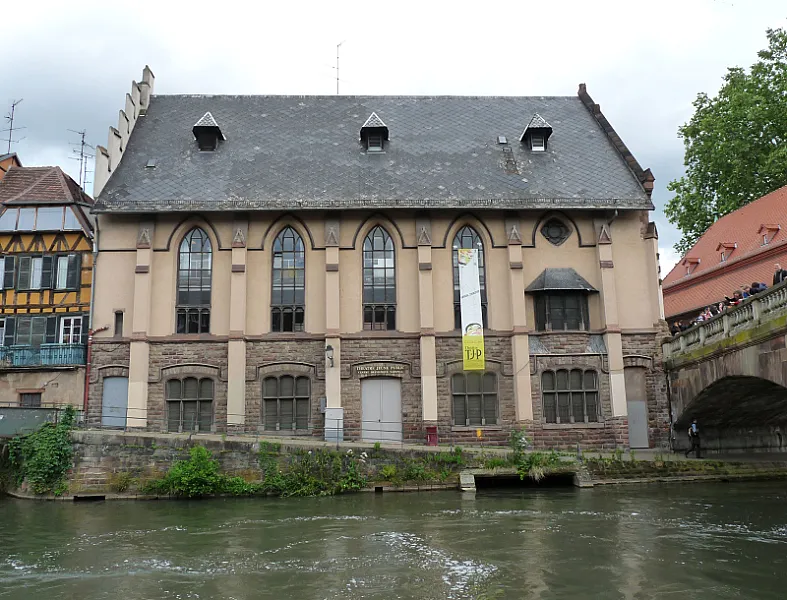
Saint-Martin Church
- The Saint-Martin church in Strasbourg was built in 1905 in Neo-Gothic style.
- The church should not be confused with Église Saint-Martin de Strasbourg from the 12th century.
- The community that met at this church moved to Meinau district in 1969 following the construction of a new Baptist church.
- The church is no longer used for worship.
- Since 1974, the building has been home to the Théâtre Jeune Public (Young Public Theatre).
- This information is part of a draft article about a church or cathedral.
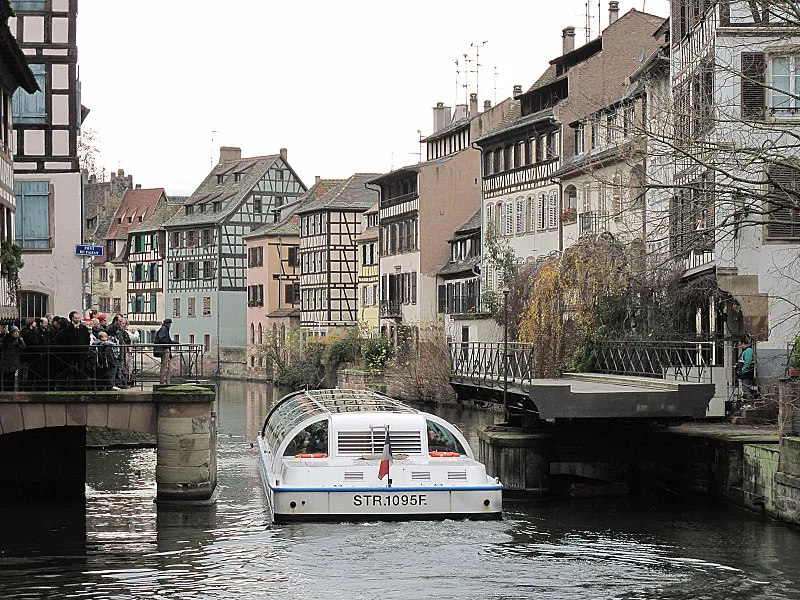
Pheasant Bridge
- The Faisan Bridge, also known as the Turning Bridge, is a 19th-century hydraulic rotating bridge.⌛ An original wooden bridge from the 14th century was replaced in 1854 by this mobile bridge to allow both pedestrians and cargo ships to pass.
- The bridge was modified into a drawbridge in 1869 and then replaced in 1888 by the current steel and wood model.
- In 1999, the bridge was renovated and improved with a hydraulic operating system.
- Today, this picturesque bridge is one of the tourist attractions of the preserved historical Alsatian neighborhood dating back to the 16th century.
- Built next to the house at 40 rue du Bain-aux-Plantes, the bridge is in proximity to numerous points of interest including the famous Strasbourg Tanners' House.

Saint-Pierre-le-Vieux Church
- The Church of Old Saint Peters was first mentioned in 1130 and was a Catholic and Lutheran simultaneum church.
- In the Middle Ages, it was one of nine parish churches of Diocese of Strasbourg.
- The church became the new home of the Abbey of Honau's chapter in 1398, due to flooding in their original location in Rhinau.
- A Latin 'Middle School' was opened at the church in 1535.
- In 1683, Louis XIV ordered that part of the church be returned to the Catholics and a dividing wall be installed.
- The church is home to various notable works of art, including Gothic paintings and wooden Renaissance reliefs, some of which have been classified as Monuments historiques.
Where to Stay in Strasbourg
Choosing the right base in Strasbourg matters because the city rewards walking and short tram hops: your neighbourhood will shape how much of the city you can soak in without wasting time. If you want to wake up and be moments from the Cathedral of Our Lady and the Statue of Gutenberg, staying on the island heart of the city makes it easy to slide into the UNESCO-listed atmosphere and to make the most of a two-day stay.
Strasbourg is compact and layered, with the medieval Grande Île at its core, lively student quarters to the north and east, and the gridded Neustadt and quieter residential streets beyond. The Seminary of St. Mary Major and Place Saint-Étienne sit close enough to each other and to the cathedral that a central location keeps your walking straightforward: mornings in the cathedral precinct, afternoons exploring nearby lanes and the riverside, evenings at a café without a long commute back to your room.
For practical neighbourhood choices, consider staying on the Grande Île if you want to be in the thick of things — the Cathedral and the Statue of Gutenberg will be part of your daily stroll. If you prefer a slightly calmer, local feel but still within easy reach of the Seminary of St. Mary Major and Place Saint-Étienne, the Krutenau area offers narrow streets, student energy and good dining options. Those who value tidy boulevards and a sense of 19th‑century architecture will find the Neustadt direction useful, especially if you want straightforward access to Rue de la Division Leclerc and tram links.
Getting around is simple: Strasbourg’s efficient tram network and compact centre mean most sights are 10–20 minutes apart. Pick accommodation with a nearby tram stop or within easy walking distance of the cathedral; arriving at Gare Centrale usually puts you a short tram ride from the heart. For an efficient two-day itinerary, base yourself where mornings can be spent at the cathedral and Seminary, afternoons around Place Saint-Étienne, and pockets of time left to wander by the Gutenberg statue and along the river.
Finally, don’t overthink it: whether you choose a central room on the Grande Île, a cosy flat in Krutenau, or a quiet street in Neustadt, prioritise proximity to transit and the cathedral area for peace of mind. With a good location you’ll waste less time in transit and more time enjoying Strasbourg’s layered streets, architecture and riverside charm. Safe travels — your short stay will feel perfectly manageable from the right base.
Getting Around Strasbourg
Strasbourg is delightfully easy to explore by public transport, and once you get comfortable with the rhythm of the city you’ll feel like a local in no time. The network run by CTS is centered on frequent tram lines (A–E) and a complementary bus system, so most sights are never far from a stop. Trams are punctual and the stops are well signed in both French and English, which makes hopping from the riverside to the Grande Île feel effortless 🚇. The city’s compact center also means many attractions are within a pleasant walk if you prefer to soak up the streetscape.
A practical tip about tickets: you can buy single tickets, multi-ride carnets, or a day pass depending on how much you plan to move around. Single fares are inexpensive (usually under a few euros) and a 24‑hour option often becomes the best value for a full day of sightseeing. Purchase at station machines, from kiosks, or via the official CTS app, and remember to validate your ticket on the validators when you board; inspectors do check. Most ticket machines accept cards and contactless payment, so you don’t need to carry lots of change 🎫.
Use Google Maps to plan routes in real time: it shows tram numbers, departure times, and walking segments clearly. Set your destination to the exact name (for example Cathedral of Our Lady or Place Saint-Étienne) and Google will give you door‑to‑door directions with platform info and estimated travel times. I rely on it constantly in Strasbourg because the app’s tram departure times are usually spot on, and it helps you decide whether to walk a scenic five minutes instead of waiting for the next tram.
Money-saving hints: if you love wandering, combine walking with trams—many central POIs are clustered so a mix of both saves fares. If you’re in town for a couple of days, a day pass or a small carnet of tickets often costs less per ride. Also look for reduced fares for youth and seniors on the CTS website before you travel.
From personal experience, when we wanted to go from the Seminary of St. Mary Major to the Cathedral of Our Lady we didn’t overthink it. We hopped on a tram toward the city center, got off at Homme de Fer, and walked along the lively streets to the Cathedral in under ten minutes. The tram dropped us close, we validated our tickets, and then enjoyed the short walk through historic lanes—simple, efficient, and joyful 🗺️. You’ll find Strasbourg’s transport welcoming and straightforward, perfect for first-time visitors.
What to Pack for Strasbourg
Two days in Strasbourg is mostly church spires, canals of La Petite France, and strolling between monuments — I learned that on my first trip when I ambitiously walked 15 miles over two days and still felt like I missed corners. Below are the essentials I pack every time, with short stories about why each item saved the day (or my feet).
1. Comfortable walking shoes (REQUIRED — e.g., Ecco Soft 7 or Merrell Moab): Strasbourg’s historic center is full of cobblestones and uneven pavements. The first time I wore flats I was miserable by hour three; with supportive shoes I easily did 10+ hours of wandering without foot pain. Choose shoes with good soles and ankle support so your knees don’t pay the price after climbing cathedral steps.
2. Cross-body bag with zippered compartments: Popular viewpoints and trams get crowded around cathedral hours. I had my phone jostled once on a packed bridge — a small, zippered cross-body stopped it sliding out. It keeps essentials handy (wallet, transit ticket, tiny guide) and deters opportunistic hands, especially in touristy areas like Place Gutenberg.
3. Weather-appropriate clothing (layered jacket, breathable layers): Strasbourg weather flips quickly — I’ve been out for 10+ hours where morning fog turned into a sunny afternoon. Layers let you visit riverside monuments comfortably and still look tidy for a cathedral interior or a café. In cooler months bring a warm mid-layer; in summer, a light sun/shower jacket is a lifesaver.
4. Power adapter (Type C/E for France, 230V): You’ll be taking lots of photos of sculptures, façades, and memorials. My camera and phone both ran low by late afternoon the last trip; having the proper European adapter meant I could charge at my hotel and not miss evening shots. Don’t assume your charger will fit French sockets.
5. Power bank (10,000–20,000 mAh): Between map navigation, photography, and checking opening times, your phone battery will drain fast. I relied on a 10,000 mAh power bank to push my phone back to 70% during a long day of exploring and festival lights — it kept me connected without hunting for cafés to plug in.
6. Optional — compact umbrella & lightweight scarf: Short showers are common; once I ducked under a café awning for 20 minutes during a sudden downpour. A small umbrella packs tiny but keeps you sightseeing without getting soaked. A scarf doubles as a layer for cool evenings and a respectful cover when visiting religious sites.
Enjoy Your Trip to Strasbourg!
In just two days you'll explore 16 carefully chosen spots across Strasbourg, packed with cathedral spires, quiet courtyards and lively squares. From the Seminary of St. Mary Major to Place Saint-Étienne and the Cathedral of Our Lady, this itinerary gives you everything you need to taste the history, architecture and charm of the city.
Remember, this is a guide, not a strict schedule — the best moments are flexible. Let your pace lead the way and leave room for the unexpected: wandering down a hidden lane, stumbling on a sculpture, or pausing for a spontaneous café stop by the Ill. The magic often happens in unplanned moments, so don't pressure yourself to see EVERYTHING; savor a few places deeply.
I hope you arrive curious and leave inspired — I'm excited for you! Embrace Strasbourg's light on the canals, the hum of markets, and the hush inside its churches. You're going to love every winding street and create unforgettable memories that will stay with you long after you return.
Want to explore in a playful way? Check out our Coddy tours: Secrets of Strasbourg and The Alchemist STRASBOURG — gamified city adventures that turn discovery into a game. They're perfect for families, friends, or anyone looking for a lively, interactive way to see the city.
Safe travels! Have fun exploring Strasbourg — enjoy every moment, and please share your stories or ask me any questions when you return. Enjoy!
Want more adventure?
Discover our urban escape games to transform your visit into an interactive adventure!





















